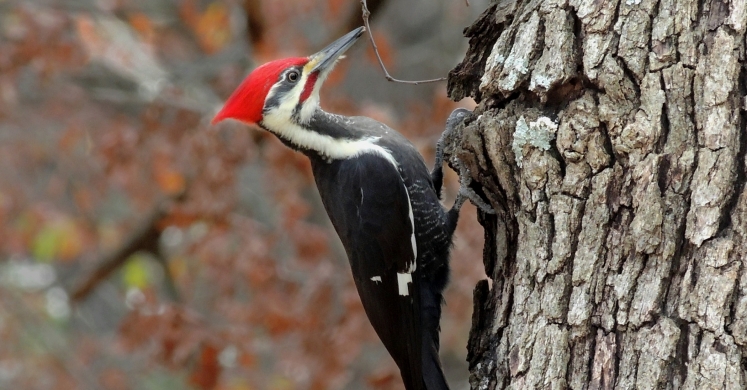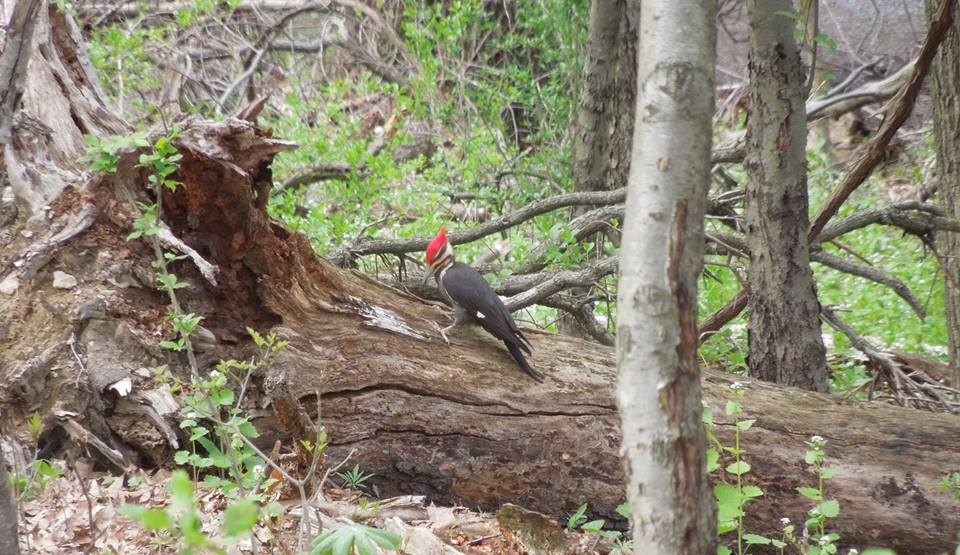Blog

#bioPGH Blog: Pileated Woodpeckers
 A resource of Biophilia: Pittsburgh, #bioPGH is a weekly blog and social media series that aims to encourage both children and adults to reconnect with nature and enjoy what each of our distinctive seasons has to offer.
A resource of Biophilia: Pittsburgh, #bioPGH is a weekly blog and social media series that aims to encourage both children and adults to reconnect with nature and enjoy what each of our distinctive seasons has to offer.
Our footsteps made quiet shuffling sounds as we continued down the Rachel Carson trail—the scenery around us glowing with new greenery as spring’s flowers gave way to leaves. Then, through the greens and earth tones of the woods, the unmistakable red of a pileated woodpecker flashed by us on its way to a nearby fallen log. Though these birds are year-round residents, their sheer size and distinctive appearance makes them an thrilling sight! Have you ever seen these birds and wondered what they were looking for as they drummed through the side of a tree? Or have you ever wondered how on earth all of the boring into wood doesn’t give them a headache? Let’s explore!
As you probably know, their characteristic hammering into wood is how the pileated woodpeckers forage for food. They rely largely on insects that can be found especially in large dead logs, such as their favorite carpenter ants and termites, and their impressive beaks break into wood quite efficiently. However, they will also eat other insects and even some plant material such as nuts and berries.
Pileated woodpeckers’ beaks are good for more than just gathering food, though. These birds often nest in cavities of trees, and it’s very likely that the parents excavated the nest on their own out of a dead tree or even utility pole. Pileated woodpeckers are also territorial, and they use their “drumming” to let others in the area know the boundaries. (This is probably why you’ve seen woodpeckers drumming on metallic or stone surfaces, where we know they aren’t looking for food.)
The important question remains, though: how on earth can woodpeckers regularly beat into wood with more G-force than it takes to knock out a football player, yet not hurt themselves? If humans replicated the behavior (don’t do it!), we would give ourselves a concussion right away, but drumming is a daily activity for them…how? As it turns out, there are a couple different factors at play here.
One is the way a woodpecker’s brain fits neatly within their skull. Our human brain has a bit of extra “space” between the brain and the skull that is filled with cerebrospinal fluid. This fluid allows our brains to float rather than be weighted down on itself, which would cut off different blood supplies and crush some neurons. The downside of this space is that during an impact to the head, our brain bashes into the inside of our skulls. Woodpeckers get around this issue by having a brain that completely fills their skull—reducing the “slosh space,” also called “slosh mitigation.” Woodpeckers also have much smaller brains than we do, which helps distribute the force of drumming evenly.
Another reason woodpeckers are able to drum away without injury is that their skulls have some mechanical differences from our skulls or even others birds. Woodpecker skulls have different placement of spongy and non-spongy bone compared to other birds, and their beaks are designed to absorb shock as well as reduce shearing forces. In addition, woodpecker’s hyoid bones act as a “seat belt” for the skull. In humans, the hyoid bone is a small, curved bone that sits just above the larynx in the throat area and adds stability to such activities as talking and swallowing. However, in woodpeckers, the hyoid bone continues all the way around the back of the skull to hold the skull in place with every forceful beat into the wood.
Wild, isn’t it? The next time you see a woodpecker at work, remember to admire all of the biology that goes into that seemingly simple behavior!
Connecting to the Outdoors Tip: If you’re hoping to spy a pileated woodpecker, they prefer to live in mature forests with older trees and even some dead trees. Pileateds can break a young tree in half with a little too much enthusiasm, thus, your best bet is to walk in sections of any of parks that have older trees.

The pileated woodpecker on the Rachel Carson Trail, April 23, 2017. Photo by Rob Dubas
Continue the Conversation: Share your nature discoveries with our community by posting to Twitter and Instagram with hashtag #bioPGH, and R.S.V.P. to attend our next Biophilia: Pittsburgh meeting.
Resources
National Geographic: Pileated Woodpeckers
Audubon Society: Pileated Woodpeckers
Wang et al. 2011: Why Do Woodpeckers Resist Head Impact Injury: A Biomechanical Investigation
Forbes - Bird Brains: Why Don't Woodpeckers Get Concussions?
Photo Credits: Wikimedia Users joshlaymon CC-BY-SA-3.0 and Greg Schecter CC-BY-2.0

